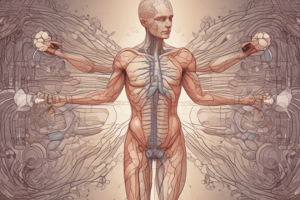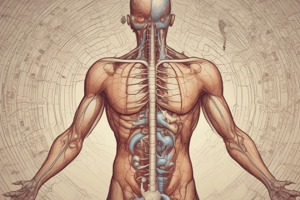Podcast
Questions and Answers
What is the name of the feedback mechanism where the distance between the hypothalamus and the pituitary is short?
What is the name of the feedback mechanism where the distance between the hypothalamus and the pituitary is short?
- Positive feedback mechanism
- Long negative feedback
- Negative feedback loop
- Short negative feedback (correct)
Which gland is primarily controlled by the nervous system?
Which gland is primarily controlled by the nervous system?
- Anterior lobe of the pituitary gland
- Thyroid gland
- Adrenal cortex
- Adrenal medulla (correct)
What is an example of a hormone that stimulates secretion of another hormone without a target gland?
What is an example of a hormone that stimulates secretion of another hormone without a target gland?
- GHRH (correct)
- Thyroid-stimulating hormone
- FSH
- GH
What is the term for periodic variations in hormone secretion influenced by seasonal changes, development, and aging?
What is the term for periodic variations in hormone secretion influenced by seasonal changes, development, and aging?
Where are the receptors for thyroid hormones typically located?
Where are the receptors for thyroid hormones typically located?
What is the first step of a hormone's action?
What is the first step of a hormone's action?
What is the importance of the shape of a receptor in hormone action?
What is the importance of the shape of a receptor in hormone action?
What is an example of a condition where there are no receptors for a hormone, leading to absence of secondary sex characteristics?
What is an example of a condition where there are no receptors for a hormone, leading to absence of secondary sex characteristics?
What is the effect of estrogens on uterine blood flow?
What is the effect of estrogens on uterine blood flow?
What is the effect of estrogens on FSH?
What is the effect of estrogens on FSH?
What is the effect of estrogens on bone growth?
What is the effect of estrogens on bone growth?
What is the effect of estrogens on libido?
What is the effect of estrogens on libido?
What are the targets of progesterone action?
What are the targets of progesterone action?
What is the effect of progesterone on estrogen receptors in endometrium?
What is the effect of progesterone on estrogen receptors in endometrium?
What is the effect of progesterone on breast development?
What is the effect of progesterone on breast development?
What is the normal plasma progesterone level in females during luteal phase?
What is the normal plasma progesterone level in females during luteal phase?
What is the effect of increased prolactin levels on LH and FSH?
What is the effect of increased prolactin levels on LH and FSH?
Which hormones are primarily secreted by the thyroid gland?
Which hormones are primarily secreted by the thyroid gland?
What regulates the secretion of thyroid hormones?
What regulates the secretion of thyroid hormones?
What is the primary effect of thyroid hormones on metabolism?
What is the primary effect of thyroid hormones on metabolism?
What is caused by excessive levels of thyroid hormone?
What is caused by excessive levels of thyroid hormone?
Which physiological action is NOT associated with thyroid hormones?
Which physiological action is NOT associated with thyroid hormones?
What effect do thyroid hormones have on carbohydrates?
What effect do thyroid hormones have on carbohydrates?
What is the basal metabolic rate (BMR) defined as?
What is the basal metabolic rate (BMR) defined as?
What is the primary function of neurotransmitters?
What is the primary function of neurotransmitters?
Which hormones are secreted by glands and transported through the blood?
Which hormones are secreted by glands and transported through the blood?
What describes the function of cytokines?
What describes the function of cytokines?
How do target tissue cells recognize hormones?
How do target tissue cells recognize hormones?
What is the role of plasma proteins in relation to hormones?
What is the role of plasma proteins in relation to hormones?
Which of the following is true regarding endocrine glands?
Which of the following is true regarding endocrine glands?
What distinguishes autocrines from paracrines?
What distinguishes autocrines from paracrines?
Which hormone's targets consist of only specific target tissues?
Which hormone's targets consist of only specific target tissues?
What physiological change is commonly associated with the loss of estrogen during menopause?
What physiological change is commonly associated with the loss of estrogen during menopause?
What role does FSH play in spermatogenesis?
What role does FSH play in spermatogenesis?
Which hormone primarily stimulates Leydig cells to produce testosterone?
Which hormone primarily stimulates Leydig cells to produce testosterone?
Which of the following is a physiological action of testosterone?
Which of the following is a physiological action of testosterone?
What happens to primordial follicles around age 45?
What happens to primordial follicles around age 45?
Which factor contributes to the physiological changes observed during menopause?
Which factor contributes to the physiological changes observed during menopause?
Which statement about testosterone biosynthesis is correct?
Which statement about testosterone biosynthesis is correct?
What is a common psychological symptom during menopause?
What is a common psychological symptom during menopause?
Study Notes
Coordination of Body Functions
- The activities of cells and organs are coordinated and controlled by the interaction of the nervous system and hormonal or endocrine system through the release of secretions:
- Neurotransmitters secreted by neurons in synaptic junctions and act locally on cell functions
- Endocrine hormones secreted by glands into the blood and act on cells in another location of the body
- Neuroendocrine hormones secreted by neurons into the blood and act on cells at another location in the body
- Paracrine hormones or substances secreted by cells into extracellular fluid and affect neighboring cells of a different type
- Autocrine hormones or substances secreted by cells into extracellular fluid and act on the function of the same cells that produced them
- Cytokines (e.g., interleukins) are peptides secreted by cells into extracellular fluid and function as autocrines, paracrines, or endocrine hormones
Target Tissue Cells
- The endocrine hormones carried by blood to cells of the body called target tissue cells have special receptors for the action of the hormone
- Types of target tissue cells:
- Many different types of cells of the body (e.g., growth hormone)
- Only specific target tissues (e.g., adrenocorticotropic hormone (ACTH))
Endocrine Glands
- Defined as ductless glands that release their products directly into the blood circulation
- Their products are called hormones, which are chemical substances produced by glands or neurosecretory cells
- Hormones act as "chemical messengers"
Feedback Mechanisms
- Short negative feedback: an example is the stimulation of secretion of growth hormone (GH) by growth hormone-releasing hormone (GHRH), which affects all body tissues, and there is no hormone released in response to it
- Positive feedback mechanism: an increase in secretion of a particular hormone from a specific gland in response to an increase in a chemical substance (e.g., follicular-stimulating hormone (FSH) secreted by the pituitary gland, which circulates in the blood to affect the ovary in females)
Mechanism of Hormone Action
- When a hormone binds to its receptor, it usually initiates a cascade of reactions in the cell
- The first step of a hormone's action is to bind to specific receptors at the target cell, after dissociation of binding protein
- Locations of hormone receptors:
- In or on the surface of cell membrane (mostly for protein, peptide, and catecholamine hormones)
- In the cell cytoplasm (found mainly in cytoplasm receptors for different steroid hormones)
- In the cell nucleus (receptors for thyroid hormones are found in the nucleus and are believed to be located in direct association with one or more of the chromosomes)
Thyroid Gland and its Hormones
- The thyroid gland secretes two major hormones: thyroxine (T4) and triiodothyronine (T3), which are responsible for body metabolism
- The thyroid gland also secretes calcitonin hormone, which is responsible for calcium metabolism
- Thyroid gland hormones are controlled by thyroid-stimulating hormone (TSH)
- Physiological actions of thyroid hormone:
- Increases transcription of large numbers of genes
- Increases cellular metabolic activity
- Increases heat production
- Increases O2 consumption and heat production
- Effects on carbohydrates, fat, and protein
- Effects on the cardiovascular system
- Effects on respiration
- Effects on the gastrointestinal system
Estrogens and Progesterone
- Effects of estrogens on female genitalia:
- Increases uterine blood flow and uterine muscle
- Causes epiphysial closure in bones
- Causes salt and water retention
- Causes a significant plasma cholesterol-lowering action
- Increases libido
- Controls female secondary sex characteristics
- Progesterone physiological actions:
- Responsible for progestational changes in the endometrium and cyclic changes in the cervix and vagina
- Has anti-estrogenic effects on the myometrial cells
- Decreases the number of estrogen receptors in the endometrium and increases the rate of conversion of estradiol to less active estrogens
- Stimulates development of breast lobules, alveoli, and supports secretory function of the breast during lactation
The Male Reproductive System
- Hormonal control of spermatogenesis:
- The maturation of spermatids to spermatozoa depends on androgen acting on the Sertoli cells
- FSH acts on the Sertoli cells to facilitate the last stages of spermatid maturation
- FSH promotes production of Androgen Binding Protein (ABP)
- Endocrine function of the testes:
- Testosterone is synthesized from cholesterol in the Leydig cells and is also formed from Androstenedione secreted by the adrenal cortex
- The biosynthetic pathways: direct pathway in Leydig cells and indirect pathway in the adrenal gland
- Testosterone physiological actions:
- Acts during development of internal genitalia
- Inhibitory negative feedback effect on pituitary LH
- Development and maintenance of male secondary sex characteristics
- Maintains spermatogenesis, along with FSH
Studying That Suits You
Use AI to generate personalized quizzes and flashcards to suit your learning preferences.
Related Documents
Description
Lectures on the coordination of body functions, including the role of the nervous and endocrine systems in controlling cellular and organ functions.




